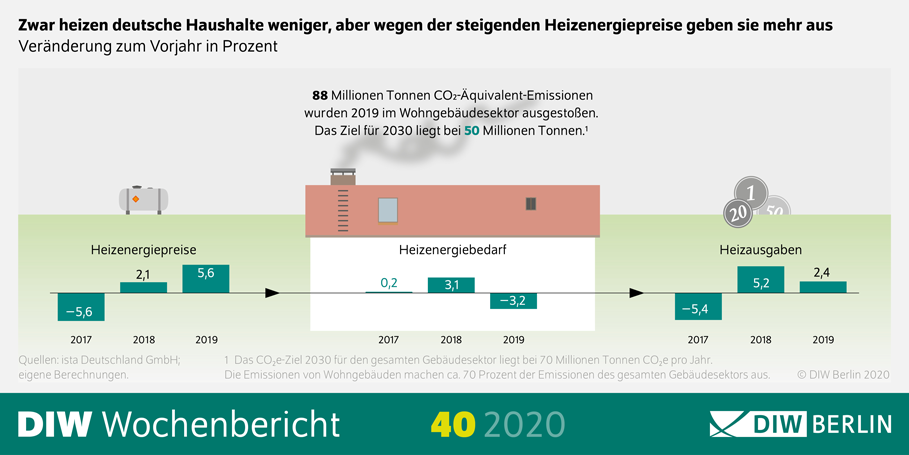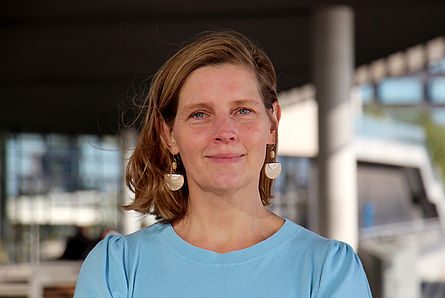Annual DIW Heat Monitor based on data from energy service provider ista Deutschland GmbH: Heating energy demand in residential buildings declines again for the first time since 2015 - Rising prices, however, cause heating expenditure to increase by 2.4 percent - CO2emissions have fallen by 21 percent overall since 2010, but by only 2.6 percent when adjusted for temperature - Energy-efficient renovation in residential buildings almost stagnant
Last year - for the first time since 2015 - tenants in Germany used slightly less heating (minus 3.2 per cent). However, at an annual average of 130 kWh per square metre of heated living space, the heating energy requirement in apartment buildings is now only back at the 2010 level. CO2-emissions have not fallen nearly as much as they would have to in order to achieve the 2030 climate targets: adjusted for temperature, they have only fallen by 2.6 per cent since 2010. These are the key findings of this year's heating monitor calculated by the German Institute for Economic Research (DIW Berlin) on the basis of data from energy service provider ista Deutschland GmbH. They are based on the heating bills of 300,000 multi-party houses in Germany and are adjusted for climate and weather conditions.
"If we only look at the absolute reduction in CO2 emissions, appearances are deceptive" Jan Stede
As energy prices for heating oil and natural gas rose by an average of 5.6 per cent last year, tenants spent 2.4 per cent more on space heating while demand fell. The regional differences in heating energy requirements and prices are very large. In western German households, seven per cent more is heated per square metre than in eastern German households. In 2019, heating energy requirements were highest in the Schleswig-Holstein Southwest and East Frisia regions, and lowest in central Mecklenburg/Rostock and Allgäu. Heating energy cost the most in Saarland and the least in Hamburg.

CO2 emissions fall mainly due to warmer winters
According to the study, there has been a significant overall reduction in CO2-emissions in the residential building sector have fallen by 20.7 per cent since 2010. However, this is largely due to the warmer winters. Adjusted for temperature and weather conditions, CO2-emissions have only fallen by 2.6 per cent over the past ten years.
"If we look at the absolute reduction in CO2-emissions, appearances are deceptive. The reduction of around 21 per cent, which would already make the climate targets unattainable, is hardly due to efforts to increase building efficiency. There is therefore no reason to scale back efforts to reduce emissions," says DIW economist Jan Stede, summarising the results.
"A sober assessment of ten years of building refurbishment shows that energy-efficient refurbishment does not automatically lead to less CO2. Climate policy measures must provide the right incentives for everyone involved: for landlords to invest and for tenant households to consume sparingly," comments Thomas Zinnöcker, CEO of energy and property service provider ista, on the results of the study. "More focus on results, unbureaucratic implementation and accompanying measures for consumers will make climate protection in buildings more effective."
Cushioning social burdens with a climate premium
Investment in the energy-efficient refurbishment of existing residential buildings is still too low to achieve the climate targets in the building sector. The plan was to increase the refurbishment rate to two per cent per year. Most recently, however, it was only one per cent. While energy-efficient refurbishment still accounted for a third of all measures in the building stock in 2010, in 2019 it was only a quarter.
The authors of the DIW study are therefore calling for stronger incentives for energy-efficient building renovations. "The higher subsidy rate for energy-efficient refurbishment and the planned CO2-pricing from next year could create additional incentives to invest more in this area again," hopes study author Franziska Schütze. With the CO2-However, care should be taken to ensure that social effects are cushioned. Tenants, especially those on low incomes, are disproportionately burdened by higher energy prices and have little influence on the building's energy efficiency and energy source. "Reimbursement of the income from the CO2-pricing in the form of a climate premium would relieve the burden on low and middle incomes and at the same time minimise the incentive effect of higher CO2-prices," suggests Jan Stede.
Links
A commentary by the German Solar Energy Society (DGS) from 2 October 2020:
www.dgs.de/news/en-detail/021020-lediglich-effizient-klimaschutz-im-gebaeude/
Source: DIW press release from 30 September 2020
Keywords:
Stock, DE-News, Research, Climate protection, New books and studies, Thermal insulation








